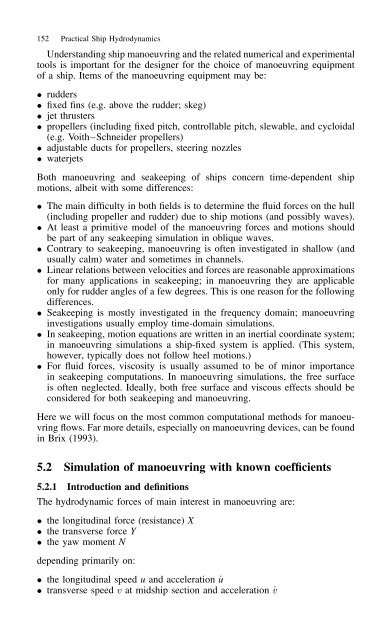Practical Ship Hydrodynamics
Practical Ship Hydrodynamics
Practical Ship Hydrodynamics
You also want an ePaper? Increase the reach of your titles
YUMPU automatically turns print PDFs into web optimized ePapers that Google loves.
152 <strong>Practical</strong> <strong>Ship</strong> <strong>Hydrodynamics</strong><br />
Understanding ship manoeuvring and the related numerical and experimental<br />
tools is important for the designer for the choice of manoeuvring equipment<br />
of a ship. Items of the manoeuvring equipment may be:<br />
ž rudders<br />
ž fixed fins (e.g. above the rudder; skeg)<br />
ž jet thrusters<br />
ž propellers (including fixed pitch, controllable pitch, slewable, and cycloidal<br />
(e.g. Voith–Schneider propellers)<br />
ž adjustable ducts for propellers, steering nozzles<br />
ž waterjets<br />
Both manoeuvring and seakeeping of ships concern time-dependent ship<br />
motions, albeit with some differences:<br />
ž The main difficulty in both fields is to determine the fluid forces on the hull<br />
(including propeller and rudder) due to ship motions (and possibly waves).<br />
ž At least a primitive model of the manoeuvring forces and motions should<br />
be part of any seakeeping simulation in oblique waves.<br />
ž Contrary to seakeeping, manoeuvring is often investigated in shallow (and<br />
usually calm) water and sometimes in channels.<br />
ž Linear relations between velocities and forces are reasonable approximations<br />
for many applications in seakeeping; in manoeuvring they are applicable<br />
only for rudder angles of a few degrees. This is one reason for the following<br />
differences.<br />
ž Seakeeping is mostly investigated in the frequency domain; manoeuvring<br />
investigations usually employ time-domain simulations.<br />
ž In seakeeping, motion equations are written in an inertial coordinate system;<br />
in manoeuvring simulations a ship-fixed system is applied. (This system,<br />
however, typically does not follow heel motions.)<br />
ž For fluid forces, viscosity is usually assumed to be of minor importance<br />
in seakeeping computations. In manoeuvring simulations, the free surface<br />
is often neglected. Ideally, both free surface and viscous effects should be<br />
considered for both seakeeping and manoeuvring.<br />
Here we will focus on the most common computational methods for manoeuvring<br />
flows. Far more details, especially on manoeuvring devices, can be found<br />
in Brix (1993).<br />
5.2 Simulation of manoeuvring with known coefficients<br />
5.2.1 Introduction and definitions<br />
The hydrodynamic forces of main interest in manoeuvring are:<br />
ž the longitudinal force (resistance) X<br />
ž the transverse force Y<br />
ž the yaw moment N<br />
depending primarily on:<br />
ž the longitudinal speed u and acceleration Pu<br />
ž transverse speed v at midship section and acceleration Pv
















